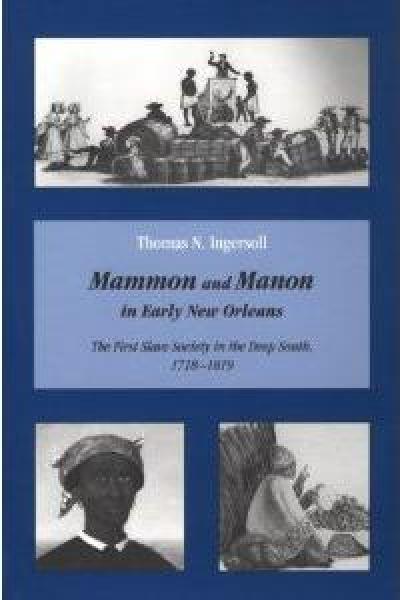Mammon & Manon Early New Orleans: First Slave Society in the Deep South, 1718-1819

Ingersoll, Thomas N.
From its very beginnings in the early eighteenth century, New Orleans was a slave society with a black majority. It combined the labor and social relations of an urban setting with those of a planter society: for much of its early history it consisted of a town center encircled by plantations. Each individual in this community was shaped by his or her color, class, and gender, but slavery structured the community as a whole. In a study that is both sweeping and finely detailed, Thomas N. Ingersoll tells the story of this city of slaves, slaveholders, and nonslaveholders and how it grew during its first century.
Drawing on a wealth of sources—judicial and sacramental records, notarial archives, administrative reports, eyewitness accounts, personal correspondence—Ingersoll illuminates the lives of those who built New Orleans against great odds. Woven throughout the book is a fascinating comparative analysis. Since Louisiana fell under the administration of France and Spain before becoming a U.S. territory in 1803, the case of New Orleans offers an opportunity to test the longstanding thesis that slave regimes under the French, Spanish, and Anglo-Americans were significantly different. Ingersoll finds that, by contrast, the city's development was remarkably continuous, affected mainly by the changing volume of its slave trade between 1719 and 1808 and thereafter primarily by urban conditions. In addition, Ingersoll disputes the conventional wisdom that early New Orleans society was anarchic—a paradise, as one writer put it, for "thieves, vagabonds, and prostitutes." In fact, Ingersoll argues, the community's development was no less orderly than that of Charleston or Savannah. Consequently, it was incorporated swiftly and easily into the United States following the Louisiana Purchase of 1803, after which it rapidly emerged as the largest and most economically important city in the South.
Ultimately, Ingersoll argues, it was "Mammon"—the lure of wealth and possessions—that ruled in New Orleans throughout its early history and imposed order on a city whose population had become remarkably diverse by 1819. In the author's view, "Manon"—the enduring image of New Orleans as a disorderly place, ruled by a sultry temptress—"deserves not modification but retirement."
The Author: Thomas N. Ingersoll is associate professor of history at the Université de Montréal. The author of articles in such journals as Louisiana History and William and Mary Quarterly, he co-organized the conference "The Family and Slavery in the Americas" at the Université de Montréal in 1994.
Filters: 1999
